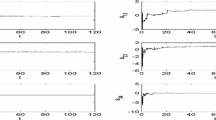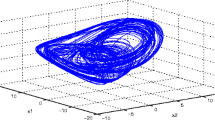Abstract
It is well known that random noise and time delay are two inherent ingredients in complex networks, whose dynamical parameters and topological structures are often unknown or uncertain. This paper will employ the techniques of impulsive control and adaptive control to infer dynamical parameters and network topology in delay-coupled complex network under circumstance noise. By constructing an appropriate adaptive–impulsive control strategy in the response network, the unknown dynamical parameters and topology structure contained in the drive network are to be accurately identified; moreover, these two networks will achieve the global exponential synchronization in mean square. Based on the comparison theorem of impulsive differential equations, the accuracy of the proposed identification strategy is rigorously proved. Finally, two examples with networks of chaotic oscillators are presented to illustrate the application of the suggested strategy. Meanwhile, numerical results indicate that our proposed scheme is robust against the impulsive gain, the update gain and the network topology.












Similar content being viewed by others
References
Watts, D.J., Strogatz, S.H.: Collective dynamics of ’small-world’ networks. Nature 393, 440–442 (1998)
Strogatz, S.: Exploring complex networks. Nature 410, 268–276 (2001)
Albert, R., Barabasi, A.: Statistical mechanics of complex networks. Rev. Mod. Phys. 74, 47–97 (2002)
Sun, W., Hu, T., Chen, Z., Chen, S., Xiao, L.: Impulsive synchronization of a general nonlinear coupled complex network. Commum. Nonlinear Sci. Numer. Simul. 16, 4501–4507 (2011)
Yu, W., Chen, G., Lü, J.: On pinning synchronization of complex dynamical networks. Automatica 45, 429–435 (2009)
Zhou, J., Lu, J., Lü, J.: Pinning adaptive synchronization of a general complex dynamical network. Automatica 44, 996–1003 (2008)
Tang, H., Chen, L., Lu, J., K. Tsec, C.: Adaptive synchronization between two complex networks with nonidentical topological structures. Phys. A 387, 5623–5630 (2008)
Hu, M., Yang, Y., Xu, Z., Zhang, R., Guo, L.: Projective synchronization in drive–response dynamical networks. Phys. A 387, 457–466 (2007)
Du, H.: Function projective synchronization in drive-response dynamical networks with nonidentical nodes. Chaos 44, 510–514 (2011)
Lu, H.: Projective lag synchronization of the general complex dynamical networks with distinct nodes. Commum. Nonlinear Sci. Numer. Simul. 17, 4417–4429 (2012)
Zhang, Q., Zhao, J.: Projective and lag synchronization between general complex network via impulsive control. Nonlinear Dyn. 67, 2519–2525 (2012)
Zhou, C., Kurths, J.: Dynamical weights and enhanced synchronization in adaptive complex networks. Phys. Rev. Lett. 96, 164102 (2006)
Li, C., Sun, W., Kurths, J.: Synchronization between two coupled complex networks. Phys. Rev. E 76, 046204 (2007)
Liu, H., Chen, J., Lu, J., Cao, M.: Generalized synchronization in complex dynamical networks via adaptive couplings. Phys. A 389, 1759–1770 (2010)
Yu, D., Righero, M.: Estimating topology of networks. Phys. Rev. Lett. 97, 188701 (2006)
Zhou, J., Lu, J.: Topology identification of weighted complex dynamical networks. Phys. A 386, 481–491 (2007)
Xu, Y., Zhou, W., Fang, J., Lu, H.: Structure identification and adaptive synchronization of uncertain general complex dynamical networks. Phys. Lett. A 374, 272–278 (2009)
Xu, Y., Zhou, W., Fang, J., Sun, W.: Topology identification and adaptive synchronization of uncertain complex networks with adaptive double scaling functions. Commum. Nonlinear Sci. Numer. Simul. 16, 3337–3343 (2011)
Tang, S., Chen, L., He, Y.: Optimization-based topology identification of complex networks. Chin. Phys. B 20, 110502 (2011)
Timme, M.: Revealing network connectivity from response dynamics. Phys. Lett. A 98, 224101 (2007)
Yu, D., Parlitz, U.: Inferring network connectivity by delayed feedback control. Plos One 6, e24333 (2011)
Xu, J., Zheng, S., Cai, G.: Topology identification of weighted complex dynamical networks with non-delayed and time-varying delayed coupling. Chin. J. Phys. 48, 482–492 (2010)
Liu, H., Lu, J., Lü, J., David, JHill: Structure identification of uncertain general complex dynamical networks with time delay. Automatica 45, 1799–1807 (2009)
Guo, W., Chen, S., Sun, W.: Topology identification of the complex networks with non-delayed and delayed Coupling. Phys. Lett. A 373, 3724–3729 (2009)
Wu, X.: Synchronization-based topology identification of weighted general complex dynamical networks with time-varying coupling delay. Phys. A 387, 997–1008 (2008)
Zheng, S., Bi, Q., Cai, G.: Adaptive projective synchronization in complex networks with timevarying coupling delay. Phys. Lett. A 373, 1553–1559 (2009)
Che, Y., Li, R., Han, C., Wang, J., Cui, S., Deng, B., Wei, X.: Adaptive lag synchronization based topology identification scheme of uncertain general complex dynamical networks. Eur. Phys. J. B 85, 265 (2012)
Che, Y., Li, R., Han, C., Cui, S., Wang, J.: Topology identification of uncertain nonlinearly coupled complex networks with delays based on anticipatory synchronization. Chaos 23, 013127 (2013)
Wu, X., Zhao, X., Lü, J.: Topology identification of complex dynamical networks with stochastic perturbations. In: Proceedings of the \(30^{\rm th}\) Chinese Control Conference (2011)
Ren, J., Wang, W., Li, B., Lai, Y.: Noise bridges dynamical correlation and topology in complex oscillator networks. Phys. Rev. Lett. 104, 058701 (2010)
Zhang, G., Liu, Z., Ma, Z.: Synchronization of complex dynamical networks via impulsive control. Chaos 17, 043126 (2007)
Zhou, J., Xiang, L., Liu, Z.: Synchronization in complex delayed dynamical networks with impulsive effects. Phys. A 384, 684–692 (2007)
Cai, S., Zhou, J., Xiang, L., Liu, Z.: Robust impulsive synchronization of complex delayed dynamical networks. Phys. Lett. A 372, 4990–4995 (2008)
Yang, Y., Cao, J.: Exponential synchronization of the complex dynamical networks with a coupling delay and impulsive effects. Nonlinear Anal. Real World Appl. 11, 1650–1659 (2010)
Sun, W., Chen, Z., Lü, J., Chen, S.: Outer synchronization of complex networks with delay via impulse. Nonlinear Dyn. 69, 1751–1764 (2012)
Yang, X., Cao, J., Lu, J.: Stochastic synchronization of complex networks with nonidentical nodes via hybrid adaptive and impulsive control. IEEE Trans. Circ. Syst. 59, 371–384 (2012)
Zhang, Q., Luo, J., Wan, L.: Parameter identification and synchronization of uncertain general complex networks via adaptive–impulsive control. Nonlinear Dyn. 71, 353–359 (2013)
Zhang, Q., Luo, J., Wan, L.: Erratum to: parameter identification and synchronization of uncertain general complex networks via adaptive–impulsive control. Nonlinear Dyn. 75, 403–405 (2014)
Liu, D., Wu, Z., Ye, Q.: Structure identification of an uncertain network coupled with complex-variable chaotic systems via adaptive impulsive control. Chin. Phys. B 23, 040504 (2014)
Yang, Z., Xu, D.: Stability analysis and design of impulsive control systems with time delay. IEEE Trans. Autom. Control 52, 1448–1454 (2007)
Lakshmikantham, V., Bainov, D., Dnov, P.: Theory of Impulsive Differential Equations. World Scientific, Singapore (1989)
Acknowledgments
This work is partially supported by the National Natural Science Foundation of China (Grant No. 11272258 and 11172342), the Fundamental Funds Research for the Central Universities (Grant No. GK201302001) and the NSF of Shaanxi Province (Grant No. 2014JQ1013). This work is also partially supported by the China Scholarship fund.
Author information
Authors and Affiliations
Corresponding author
Appendix
Appendix
The Proof of the Theorem.
Proof
Let \(\widetilde{\theta }_i (t)=\overline{\theta }_i (t)-\theta _i \), \(\widetilde{b_{ij} }(t)=d_{ij} (t)-b_{ij} \), \(e_i (t)=y_i (t)-x_i (t)\), \(\left( {i,j=1,2,\ldots M} \right) \). Subtracting the drive network (1) from the response network (2) and using the controller (3) and (4), then the synchronization error between the drive network and the response network can be written as
where \(\sigma _i (e_i (t),e_i (t-\tau (t)),t)=\sigma _i (y_i (t),y_i (t-\tau (t)),t)-\sigma _i (x_i (t),x_i (t-\tau (t)),t)\), \(\phi _i (s)=({\widetilde{\theta }_i }(s),{\widetilde{b}_{ij} }(s),k_i (s),e_i (s))\in R^{m_1 +M+1+n}\) is the initial value of (12).
Introduce the following V function
where \(L=\max \limits _{1\le i\le M} \{L_i \}\), \(\alpha =\lambda _{\max } \left( \frac{1}{2}CC^{T}\right) \), \(C=B\otimes A\), \(\otimes \) is the Kronecker product.
Since the impulsive controller acts only at impulsive instant, and \(d_k =0\) for any \(t\in (t_{k-1} ,t_k )\), thus the V function can be written as for \(t\in (t_{k-1} ,t_k )\)
Applying the \(It\hat{o}\) formula to the combined equations of the error dynamical network (12) and the adaptive update laws (5)– (7), then the differential operator \(\ell V\)can be derived as follows
From \((H_1 )\) and \((H_2 )\), one can obtain, respectively, that
and
Then (13) can be rewritten as
Let \(e(t)=(e_1 ^{T}(t),e_2 ^{T}(t),\ldots ,e_M ^{T}(t))^{T}\in R^{nM}\), then
It follows from Lemma 1 that
Hence,
According to the \(It\hat{o}\) formula, we have
Taking mathematical expectation on both sides of the above inequality, one can obtain that
When \(t=t_k \), \(e_i (t_k )=\Delta e_i (t_k )+e_i (t_{_k }^- )=-d_k e_i (t_{_k }^- )+e_i (t_{_k }^- )=(1-d_k )e_i (t_{_k }^- )\).
Then the V function can be rewritten as
In view of (8), we have \(V(t_k )\le \beta V(t_{_k }^- )\), hence
For any \(\delta >0\), let \(\upsilon (t)\) be a unique solution of the following impulsive delay system
where \(\phi (s)=(\phi _1^T (s),\phi _2^T (s),\ldots ,\phi _M^T (s))^{T}\) is the initial value of (12).
Since \(EV(s)\le E\left\| {\phi (s)} \right\| ^{2}=\upsilon (s)\) for \(s\in [-\bar{\tau },0]\), it follows from Lemma 2 (i.e., the comparison theorem of impulsive differential equations) that
Considering the formula for the variation of parameters [41], we have
where \(P(t,s),\, t,s\ge 0\) is the Cauchy matrix of linear system
In view of the representation of the Cauchy matrix, we can get the following estimation
where \(a=-(2p+\frac{In\beta }{\zeta })\).
Let \(\gamma =\beta ^{-1}\sup \limits _{-\bar{\tau }\le s\le 0} \{E\left\| {\phi (s)} \right\| ^{2}\}\), then it can be derived from (19) and (20)
Now we introduce the following function
It follows from (9) that \(h(0)=-a+(2q+1)\beta ^{-1}<0\). Since \(h(+\infty )=+\infty \) and \(h^{{\prime }}(\mu )>0\), there exists a unique \(\lambda >0\) such that
From (9), it is obvious that \(a\beta -(2q+1)>0\), therefore,
In the following, we shall prove that
If this is not true, there will exist a smallest nonnegative \(t^{*}\) such that
and
Combining (21) with (24), we have
In view of (22) and (26), we have
Obviously, the above inequality contradicts (25). Thus, the inequality (23) holds. Letting \(\delta \rightarrow 0\), we can get from (18) that
Therefore, we can derive that \(E\left\| {e_i (t)} \right\| ^{2}<2\gamma e^{-\lambda t}\left( {i=1,2,\ldots ,M} \right) \) from the V function. From the Definition, we know that the solution \(e_i (t)=0\) of (12) is exponentially stable in mean square, which means that the response network (2) can exponentially synchronize the drive network (1) in mean square. Moreover, from \((H_3 )\), Equations (7) and (12) one can obtain that \({\widetilde{\theta }_i}(t)=0, {\widetilde{b}_{ij} }(t)=0\) are also exponentially stable in mean square, and the feedback strength \(k_i(t)\) convergences to some constants. Thus, the unknown dynamical parameters and topology structure contained in the drive network (1) are to be accurately inferred during the process of synchronization between the drive network (1) and the response network (2). This completes the proof of the Theorem. \(\square \)
Rights and permissions
About this article
Cite this article
Yang, X.L., Wei, T. Revealing network topology and dynamical parameters in delay-coupled complex network subjected to random noise. Nonlinear Dyn 82, 319–332 (2015). https://doi.org/10.1007/s11071-015-2160-8
Received:
Accepted:
Published:
Issue Date:
DOI: https://doi.org/10.1007/s11071-015-2160-8




